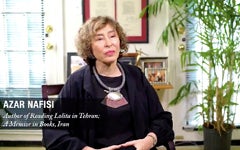
How can a fashion show help to bring about the end of a civil war? That’s one of the many stories told in the Profiles in Peace Oral History Collection, now available in DigitalGeorgetown.
Profiles in Peace is a project of the Georgetown Institute for Women, Peace, and Security. “For almost as long as we’ve existed, we’ve been interviewing women about their experiences” and work to bring about peace, said Sarah Rutherford, GIWPS director of external affairs. Over the past three years, however, they’ve been working with oral historian Maggie Lemere to change their strategy from formal interviews to collecting oral histories.
“An oral history is a full, in-depth life story of someone where the person who tells the story is in control of their representation,” Lemere explained. They are more like conversations than interviews, and frequently offer more depth, providing nuance and giving the subject the opportunity to share highs and lows and their visions of the future.
Nobel Peace Prize winner Leymah Gbowee’s oral history, for example, describes how her early work with the Women in Peacebuilding Network included organizing “resocialization” activities—including the aforementioned fashion show—for women that helped them realize that they did not need to limit their potential based on their parents’ wishes or societal norms. That experience helped her develop into an activist who, a few years later, led a successful protest by women who threatened to remove their clothes if negotiators couldn’t come to an agreement in peace talks during the Second Liberian Civil War. “The interview reveals how women get confident enough to be empowered to do that, and how they realize they’re capable of it,” Rutherford said.
“Often women are seen as stereotypes and presented as the worst things that happen to them—as a victim or a refugee, for example,” Lemere said. “An oral history allows us to connect the dynamic experiences in a person’s life and see them as more than a label, and to connect their experiences to their leadership.”
The project’s goal is to create a world-leading archive of women’s experiences in conflict that will be valuable for students, scholars, activists, and other peacebuilders. The interviews can also be used in documentaries and other cultural works.
The Library’s involvement is an important component of the project. “Often people collect interviews, but they’re not archived and the potentially valuable material gets lost,” Lemere said. “We knew we needed to find an archive that would be equally excited about this project.” GIWPS worked with Library Head of Information Technology Suzanne Chase and Assistant Archivist Ann Galloway to formalize the standards for the project for everything from audio quality to the necessary release forms. Another significant contributor was CCT student Andreas Biessel (G‘21), who created transcripts and edited video interviews.
“Preserving the Profiles in Peace oral history collection enables the University Archives to meet our mission of collecting and preserving material of enduring value produced by the extraordinary staff and researchers at Georgetown,” said Ann Galloway, assistant University archivist.
“Making this resource available in Digital Georgetown, with its emphasis on curation and preservation, furthers the Library’s mission to shape the creation of knowledge, conserve culture for posterity, and transform learning and research,” added Library Information Technology Head Suzanne Chase.
GIWPS formally launched the Profiles in Peace Oral History at an online event March 5 featuring peace activists Azar Nafisi, Binalakshmi Nepram, and Soraya Chemaly. A recording of the event will soon be available at the event homepage.
Ten oral histories are currently available in DigitalGeorgetown, and several more are underway. Each oral history is available as a video and a transcript.
